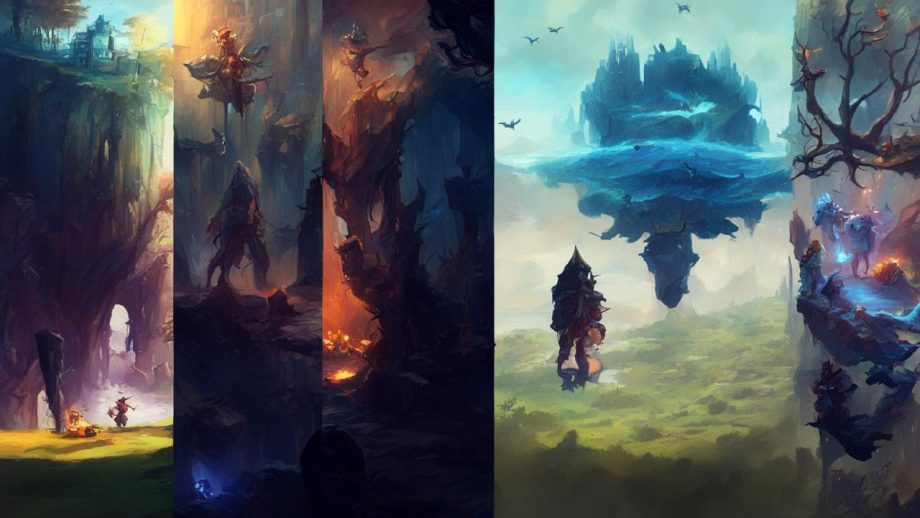Have you ever struggled to come up with ideas for your game? If so, you are not alone. Many game developers face this challenge, especially in a competitive and saturated market. But don’t worry, we are here to help you…
In this post, we will share some tips and methods on how to find and generate game ideas, whether you prefer a creative or a systematic approach. We will also show you some examples of successful games that started from simple or unexpected ideas. By the end of this post, you will have a better understanding of how to find ideas for your game, and hopefully, some inspiration to start your project.
How to Find Game Ideas: Creative
Finding ideas for your game can be challenging, but also rewarding. There are many sources of inspiration and methods to generate game ideas, such as playing other games, observing the world, asking people, using books, movies, or generators, participating in game jams, and more. You should also consider the market and genre you want to target, and balance your creativity with the needs and preferences of your potential players. You should have a clear vision and purpose for your game, and what you want to achieve with it. You should also seek help and feedback from others, such as your team, mentors, testers, or fans, and collaborate with them to improve your game. Finding ideas for your game is not a one-time process, but a continuous and iterative one, that requires passion, curiosity, and experimentation.
One of the most important things to remember when finding ideas for your game is that there is no right or wrong answer. This can give you the courage and confidence to explore different possibilities and try new things. Finding ideas is not a mechanical process, but a creative one. Everyone can have different ideas depending on their situation, background, and perspective. A good way to stimulate your imagination is to put yourself in various situations, mentally and physically. This may sound strange, but it can help you discover new angles and insights that you may not have thought of before. Don’t limit yourself to a fixed mindset or a narrow scope. Remember that there are many problems and challenges in the world, and even more solutions and opportunities. There is no right or wrong idea, just a choice. And that choice depends on you and your team, what kind of people you are, what your goals and values are, what your strengths and weaknesses are, and what you want to achieve with your game.

Limits: Let’s Create Some!
After you have explored various ideas and possibilities, it’s time to be realistic and set some boundaries. This is the essence of creation: putting infinity in a box. You need to define the scope and scale of your game and make some decisions that will shape your project. One of the first decisions you need to make is the genre of your game. What kind of game do you want to make? A platformer, a puzzle, a shooter, a simulation, a role-playing game, or something else? Choose a genre that suits your vision and passion, but also be aware of the expectations and conventions of that genre. Remember that these choices are not easy to change later, so be careful and confident. Another decision you need to make is the size and composition of your team. Are you making a solo game, or working with others? How many people are involved, and what are their roles and responsibilities? How will you communicate and collaborate with them? You also need to assess your current skills and abilities, and what you need to learn and improve. What are your strengths and weaknesses as a game developer? What tools and software do you need to use, and how proficient are you with them? What skills or knowledge do you need to acquire or enhance, and how will you do that? By answering these questions, you will have a clearer picture of your game project and a more focused and realistic approach. You will also have a smaller and more manageable set of choices, making your game development easier and faster.

Main Goal: What Do You Want?
The final decision you need to make before you start developing your game is your main goal. What is the point of creating this game? What do you want to achieve with it? Is it about money, fame, passion, fun, or something else? There is no shame in being honest and clear about your motivation, as it will guide your game development and help you measure your success. You can have multiple goals, but you should prioritize them and focus on the most important ones. For example, if your main goal is to make money, you should consider the market demand, the monetization strategy, and the budget of your game. If your main goal is to gain fame, you should consider the publicity, the marketing, and the reviews of your game. If your main goal is to express your passion, you should consider your game’s message, theme, and style. Whatever your goal is, you should write it down and keep it in mind throughout your game development. By the end of this step, you will have a clear image of your game and what you want. Trust me, that’s everything. Now, let’s get into the game development part.
Make the Table: Compare and Contrast Your Goals and Games
Now that you have defined your main goal and some secondary goals for your game, it’s time to make a table to compare and contrast them with some existing games that achieved those goals. This will help you to see what works and what doesn’t, and to learn from the successes and failures of other game developers. To make the table, you need to write your goals in order of priority in the columns and write the names of three games that best represent each goal in the rows. For example, if your main goal is to make an indie co-op game, you can write that in the first column, and then write the names of three indie co-op games that you admire or enjoy in the first row. In the next columns, you can write your other goals, such as fame, money, or fun, and then write the names of three games that achieved those goals in the corresponding rows.
Once you have made your table, you can talk about your team and how each game relates to your goals. You can discuss the strengths and weaknesses of each game, the similarities and differences between them, and the lessons and insights you can apply to your own game. You can also mention the genre, style, mechanics, features, and audience of each game, and how they fit or contrast with your own game. By the end of this step, you will have very useful data for your next step, which is to start prototyping your game.
What Makes These Games Successful?
Now that you have made your table and compared your goals and games, it’s time to find the commonalities between them. What are the elements or factors that make these games successful and popular? How can you use them to inspire your own game? To find the commonalities, you need to analyze each row of your table and look for the similarities and patterns among the three games in each category. For example, if you look at the row of the most famous indie games, which are Undertale, Cuphead, and Minecraft, you can see that they have some things in common, such as:
They are all gameplay-based, meaning that they focus on the mechanics, systems, and interactions of the game, rather than the graphics, story, or characters.
They all have a unique and distinctive art style, that sets them apart from other games and creates a memorable impression on the players.
They all have a simple and intuitive camera angle, that allows the players to see and control the game easily and comfortably.
You can do the same for the other rows of your table, and find the commonalities between the games in each category. Once you have found the commonalities, you can talk about them with your team and your friends, and see how they relate to your own game. You can also use them to generate new ideas or refine your existing ones, and to create a vision and a direction for your game development. By the end of this step, you will have a better understanding of what makes a good indie game, and how to apply it to your own game.
What Kind of Game Do You Want to Make?
Now that you have a lot of data and concept, it’s time to choose your game type. What kind of game do you want to make? This will depend on your goals, your preferences, and your audience. You need to consider the following aspects of your game:
The perspective: Do you want your game to be third-person, first-person, or top-down? This will affect how the player sees and interacts with the game world and the characters.
The genre: Do you want your game to be strategic, action, adventure, puzzle, or something else? This will affect the gameplay, the mechanics, and the challenge of your game.
The story: Do you want your game to be story-based, or simple story and gameplay-based? This will affect the narrative, the theme, and the emotion of your game.
The style: Do you want your game to be realistic, cartoonish, pixelated, or abstract? This will affect the art, the sound, and the atmosphere of your game.
The tone: Do you want your game to be serious, humorous, dark, or light-hearted? This will affect the mood, the dialogue, and the message of your game.
You can use the table you made in the previous step to help you choose your game type. You can look at the games that match your goals, and see what kind of game they are. For example, if you have shooter mechanics all over your table, you might want to make a shooter game. But what kind of shooter game? Is it a platformer shooter with no violence, or a shoot-to-kill game? You can use the commonalities you found in the previous step to guide you. You can also think about your target audience and what they would enjoy and expect from your game. By the end of this step, you will have a clear idea of what kind of game you want to make, and how to make it appealing and unique.

How to Get Feedback and Support for Your Game
Of course, you should not work on your game in isolation. You should also participate in game jams, discord talks, and other online communities that can help you clear your ideas about your game and get feedback and support from other game developers and players. These are great opportunities to test your game, learn new skills, network with others, and have fun. discord servers, and online forums for indie game developers. But remember this process that we explained will help you to understand what you or your team want, and to create a game that reflects your vision and passion. Don’t forget that this journey is about what you want and that you are the ultimate creator of your game.

